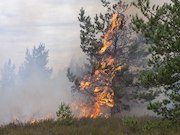Increased risk of all-cause cardiovascular, cerebrovascular ER visits, especially for over-65s
WEDNESDAY, April 11, 2018 (HealthDay News) — For all adults, and especially for those older than 65 years, smoke exposure is associated with cardiovascular and cerebrovascular emergency department visits, according to a study published online April 11 in the Journal of the American Heart Association.
Zachary S. Wettstein, from the University of California San Francisco, and colleagues conducted a population-based epidemiologic analysis for daily cardiovascular and cerebrovascular emergency department visits and wildfire smoke exposure in 2015 for adults from eight California air basins. Based on model-estimated concentrations of fine particulate matter, satellite-imaged smoke plumes were classified as light, medium, or dense. For lag days one to four, the relative risks for emergency department visits were determined.
The researchers found that across all lags, the rates of all-cause cardiovascular emergency department visits were increased, with the greatest increase seen on dense smoke days and among those aged ≥65 years at lag 0 (relative risk, 1.15). There was a correlation for cerebrovascular visits with smoke, especially for those aged 65 years and older (relative risk, 1.22 for dense smoke, lag 1). As expected, respiratory conditions were also increased (relative risk, 1.18 for adults >65 years, dense smoke, lag 1). For the control condition of acute appendicitis, there was no correlation.
“Analysis of an extensive wildfire season found smoke exposure to be associated with cardiovascular and cerebrovascular emergency department visits for all adults, particularly for those over aged 65 years,” the authors write.
Copyright © 2018 HealthDay. All rights reserved.








